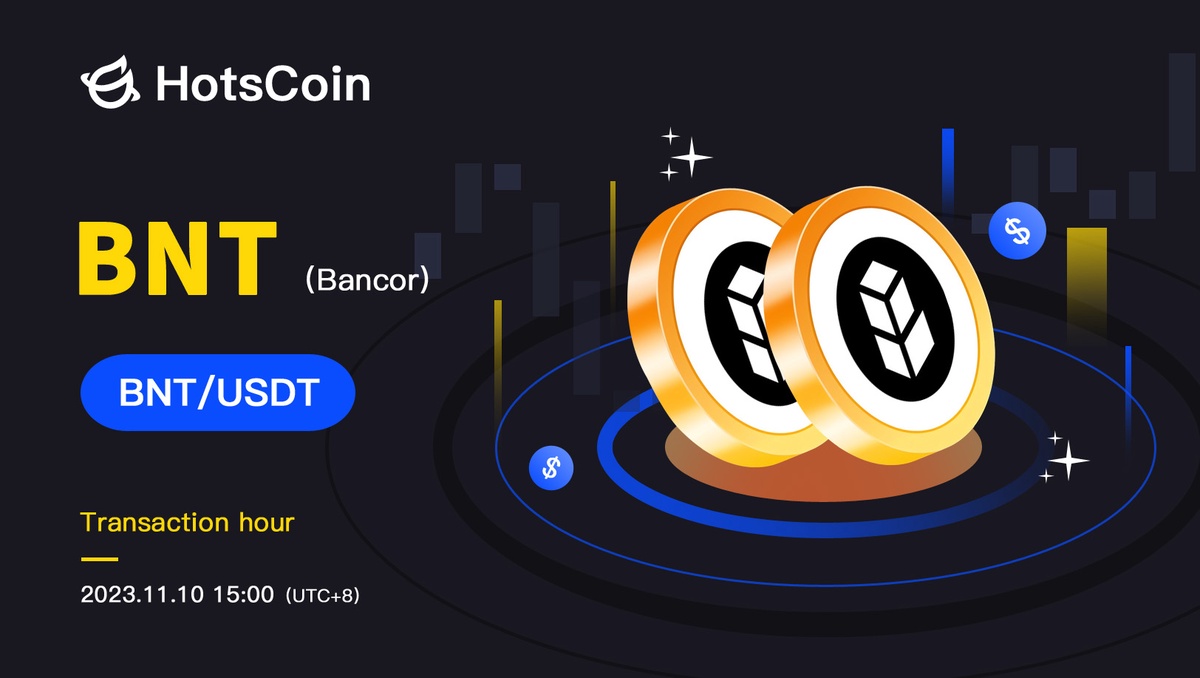On November 10th, Bancor (BNT) made its official debut on HotsCoin. Bancor (BNT) is a decentralized on-chain automated market maker (AMM) network designed to support instant, low-cost transactions and provide one-sided liquidity provision and 100% impermanent loss protection for any tokens listed on exchanges. As a pioneer in using AMM to facilitate token trading on the Ethereum-based DEX, Bancor has created a permissionless token exchange market committed to supporting the thriving token economy. Currently, BNT is available for trading on HotsCoin.

HotsCoin provides key information about BNT:
- Circulating Supply: 141,538,650.276 BNT
- Total Supply: 161,196,921.341 BNT
- Circulating Market Cap: $117,365,468.884
- Fully Diluted Market Cap: $133,666,332.26
Key Events related to BNT as noted by HotsCoin:
- June 13, 2017: Bancor completes a $153 million fundraising through an ICO.
- June 12, 2017: Bancor goes live on the mainnet.
Overview of the Bancor Project:
HotsCoin recognizes Bancor as a decentralized exchange (DEX) with a focus on addressing impermanent loss issues. The core mechanism in its v2.1 version is the BNT elastic supply, designed to compensate liquidity providers for impermanent loss, essentially achieving 100% coverage while maintaining long-term sustainability of the economic model. In the v3 version, Bancor plans to make improvements and feature upgrades to further enhance user experience and yields.
HotsCoin highlights Bancor's investment summary:
Bancor was an early mover in AMM DEX but saw its market share decline with the emergence of AMM DEX like Uniswap and Sushiswap. Subsequently, Bancor chose to focus on addressing impermanent loss and achieved minimal impermanent loss for liquidity providers through its v2.1 version. Investors should keep an eye on the protocol's development, especially with the release of v3, which promises optimizations for impermanent loss solutions and improvements in other protocol performance.
HotsCoin notes BNT's economic model:
Supply
BNT's initial ICO total supply was 79,323,978, which later transitioned from dynamic supply to fixed supply over two years, reducing the total supply to 69,148,642. Following the deployment of the v2 version and liquidity mining, BNT became an inflationary token. As of November 24, 2021, the maximum supply of BNT is 234,106,568, with approximately 83.11% staked in the protocol, resulting in a circulating token supply of around 40 million BNT.
HotsCoin observes BNT's liquidity mining:
The team initiated liquidity mining in November 2020, spanning 72 weeks, providing BNT rewards to liquidity providers in the whitelist pool every week.
Large pools receive 100,000 to 200,000 BNT per week, while medium-sized pools get 10,000 to 20,000 BNT per week.
Every two weeks, two new tokens can be added to the liquidity mining program.
Demand
In the v2.1 version, whitelist pools for liquidity protection have an upper limit setting, requiring users to increase the BNT token amount they deposit when depositing other tokens. Users depositing BNT receive vBNT, which can be used for governance and protocol transaction fees. In the v3 version, user actions of depositing BNT within the protocol will seek the most optimal BNT yield automatically, potentially increasing the demand for BNT.
Analysis:
BNT's inflation is mainly driven by liquidity mining, and the protocol mints BNT to compensate for impermanent loss. As unlimited liquidity has almost no impact on the actual circulating token supply, the total BNT supply is largely affected by BNT minting through liquidity mining and impermanent loss compensation (when fees cannot cover impermanent losses).
In the v3 version, the protocol's minting of BNT tokens may increase, leading to potential further growth in the token supply. The implementation of instantaneous liquidity protection may create arbitrage opportunities, increasing the pressure on BNT token minting for compensation.
In summary:
In the v2.1 version, BNT's total supply inflation is primarily due to liquidity mining and protocol minting of BNT, and the elastic BNT economic model appears viable.
Unrestricted liquidity results in increased protocol liquidity and, therefore, a growth in BNT total supply. However, BNT tokens minted within the protocol reduce when liquidity is removed, with almost no impact on the actual circulating token supply.
Instantaneous liquidity protection may introduce arbitrage opportunities, potentially increasing the issuance of BNT tokens for compensation.
This report aims to provide an overview of the Bancor project. Investors are encouraged to conduct thorough research and due diligence before investing, staying informed about the project's latest developments and risks. HotsCoin will continue to monitor the project's ecosystem. (Report written as of November 2023)


No comments yet